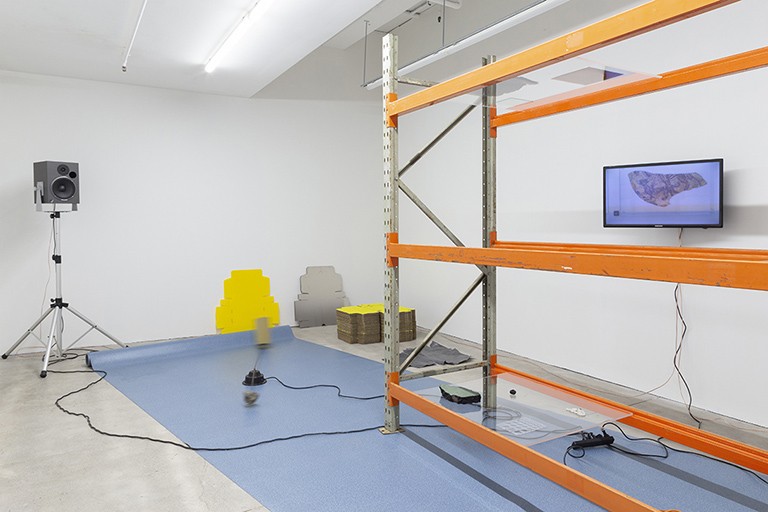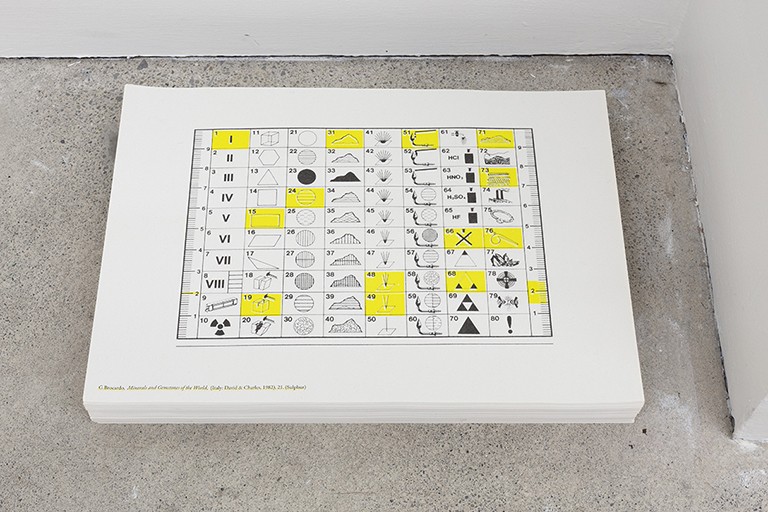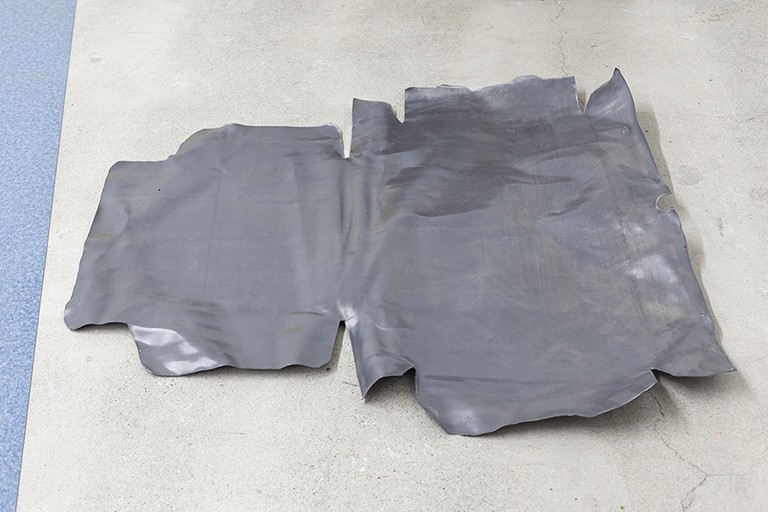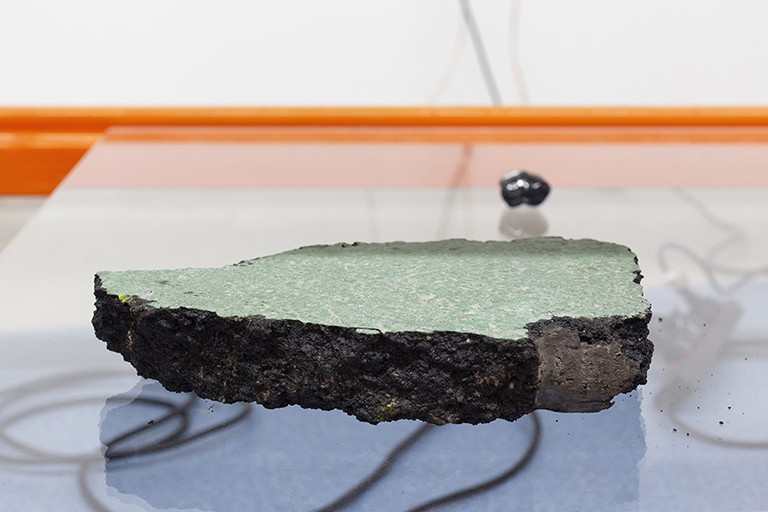Exhibition Essays
Crystal Systems
July 2022
Crystal Systems
Flora Feltham
At archiving school, my favourite quote came from Hilary Jenkinson, the starchy father of modern archival theory. The good archivist is perhaps the most selfless devotee of Truth the modern world produces he’d said. 1 In class, we laughed about it during a lecture on filing cabinets. I didn’t feel like a selfless devotee of Truth, more like someone whose pedantry could finally serve a purpose, maybe even be spun-up as charming? Luckily, my classmates and I were being taught to channel our innate fastidiousness into a professional skill. The world is messy, archival theory says, chocka with mucky odds and ends, so archivists organise the muddle—and therefore the world—into something orderly, logical. Despite laughing at Jenkinson’s bombast, we relished the possibility that we were above mess. We didn’t challenge the idea that neatly organised draws or shelves could combat ambiguity and deliver understanding. Reverent, we whispered the names of French archiving principles we couldn’t quite pronounce, Respect des Fonds and Provenance. They offer strict instruction: put things that belong together, together.
Ziggy Lever’s installation Document Scales is interested in similar habits of thinking and the people who deploy them. What does it mean for one object to belong with another, Lever asks? What mental contortions do we use to make our environment legible, certain? To ask these questions Document Scales brings together three tiny worlds and scrutinises them with love. They all orbit the same slippery human habits—producing and caring for information—but one is ordinary, the other two more eccentric: how we file paper documents, rare texts held in a Berlin museum, and the North Shore Rockhounds, an amateur geology club. Document Scales encourages us to meditate on these practices and consider the assumptions beneath them.

Ziggy Lever, Document Scales (install view), 2022. Image courtesy of Cheska Brown.
When I stepped inside Document Scales its sensibility felt immediately familiar, like I’d stumbled into one of the temperature-controlled storerooms where I’ve stacked boxes and written notes. A huge industrial shelving unit loomed in the centre: dinged-up metal, bright orange; so tall I had to stand on tiptoe to see the top. While everything was clean and neatly arranged, something improvised lingered about the space too, like my dad’s garage when it’s tidy. Partially unrolled blue lino unfurled diagonally across the floor; cables crisscrossed the room, lying in piles of thick orange coils. Clearly, I’d entered one of the backrooms of the world.
I was sure I’d interrupted someone too. They’d just nipped from the room, but the space still held that unmistakable air. Somebody else, absorbed. Their unknown activity thrummed from the objects they left behind. A motorised counterweight system swirled in broad lazy circles on the floor, like a fan accidentally left on. Shoved against the gallery’s white walls a stack of paper waited to be filed or taken home, leaf by leaf. The shelving unit was empty except for three groups of rocks, chipped from as yet unknown landscapes and arranged into idiosyncratic strata. If I paid attention long enough, would I understand the riddle that animated this room?

Ziggy Lever, Document Scales (detail), 2022. Image courtesy of Cheska Brown.
I found my inability to exactly place Document Scales wildly compelling. Where an archive appeals to ‘universal’ values like Truth and tends to be organised alphabetically or chronologically, a garage or workshop bears one person’s thumbprint, often laid out according to the singular logic of an eccentric mind. This ambiguity between the two doesn’t humiliate or devalue the archive, but alights upon its humanity, the idea that any practice that involves caring for objects or documents, has an innate connection to the hand, actual humans, and their subjective choices. At every turn, people are the absent centre of this installation.
Document Scales, like archiving school, begins with the micro-history of how people file paper. “There is an awkwardness to the way in which a sheet of A4 paper fits inside of a foolscap filing box,” Lever writes in his artist statement. He describes this awkwardness in its physical form: A4 paper is narrower and shorter than the foolscap box so a stack of documents slips around, like feet in a pair of too-big shoes or badly packed cargo in a ship’s hold. The box was designed to fit a historic paper size, foolscap folio. It’s the paper of Europe’s early print history, the smudged ink, clanking workshops and gothic font. Foolscap folio has been replaced by A4 paper but “boxes made to its specific measurements are ubiquitous” [ibid]. The box itself is a remnant, a fossil of old knowledge forms shrouding the new.
Foolscap folio seems at peace with human imprecision. It’s muddy birth means we can’t even be sure how it got the name foolscap. A4, meanwhile, is a paper of enlightenment rationalism. It belongs to the twentieth century, smooth and warm from the photocopier. The A Series (A0–A10) was invented by a German engineer and its sizes were calculated around the square root of two. This means that two A4 sheets, placed sideways, fit exactly onto one A3 sheet to ensure “there is neither waste nor want.”2 So, there it is, buried at the end of a Wikipedia paragraph, the design ideology of A4 paper. There is neither waste nor want.
Paper sizes, filing boxes. These objects are so common you forget they’re something people had to invent, that they have a history; even express moral principles. Document Scales refuses these objects their characteristic anonymity. A huge stack of unfolded foolscap boxes—warm lemon-yellow—rises into a plinth. Two more lie propped against the wall in a gesture both haphazard and talismanic. Their materiality has been transformed, one into glossy yellow Perspex, the other shining aluminium. One final foolscap form in lead, crumpled alone on the floor, looks more and more like an animal skin rug every time I glance at it, unnerved.

Ziggy Lever, Document Scales (detail), 2022. Image courtesy of Cheska Brown.
I can’t help but think about the manoeuvre inherent to readymade art objects and how it mirrors a manoeuvre inherent to archiving, though archival theory doesn’t like to admit it. Three important principles underlie readymades:
…first, that the choice of object is itself a creative act. Secondly, that by cancelling the ‘useful’ function of an object it becomes art. Thirdly, that the presentation and addition of a title to the object have given it ‘a new thought’, a new meaning.3
Archivists also change the context of objects to generate “new thought”. We take a photo album from under someone’s bed, removing it from the private space of personal meaning, and store it in a vault alongside all the other photo albums found under all the other beds. It becomes an archival record, official evidence to be consumed by the public sphere of History. People are now supposed to use this information to generate a fresh story about the Past, the Nation or Society.
But whose new thoughts are they, really? For my first job, in a team called Arrangement & Description, I was responsible for maintaining what archivists call ‘physical and intellectual control’ over archives. Physical control just means placing material in the right-sized box: foolscap, transit, Hollinger, four-flap. Intellectual control means putting items in the right conceptual container. We would skim-read documents and summarise them for the library catalogue. We added titles, noted dates and names, and listed all relevant themes and subjects. Every day we’d debate the trickier categories in a standing meeting before morning tea. A collection of bus tickets, for example, represents both ‘Transport History – New Zealand’ and ‘Ephemera – Graphic Design’ but which is more relevant to the collection’s essence? A bus ticket might be a spurious example but this is high-stakes work. Archivists mediate every single collection with our subjective interpretation. The Truth is, really, just a few people’s idle suggestions.
The difference between artists and archivists is that the artist is accurately recognised as someone who creates and manipulates meaning by altering an object’s context, by cancelling its original function in favour of a new one. That is their stated job. The good archivist, on the other hand, doesn’t want to know they occupy the same role. We like to think of ourselves as pure ciphers. Document Scales reinserts archivists, and people wherever they are effaced from the production of knowledge, back into the meaning-making process. It is always people who select, curate, decide.

Ziggy Lever, Document Scales (detail), 2022. Image courtesy of Cheska Brown.
The soundscape enveloping Document Scales is also archival. It’s a found soundtrack, cavernous and ambient, recorded in the reading room of Berlin’s Neues Museum. Waves of faraway human babble never quite resolve into sense. It reverberates most closely with the video component of Document Scales, where we stand in Lever’s shoes for four minutes as he films the same museum’s automated drawers opening and closing, revealing rare text fragments. We gaze at papyrus, parchment and stone tablets as they flow past, no doubt pinned to custom-sized acid-free foam behind UV-deflecting glass.
At first the video provides a purely textural experience. Letters and images glide onwards, glyphs I will never understand, a babble of data. I’m offered some understanding by the roomsheet materials list, a green leaflet clutched in my hand. In it Lever has transcribed the wall copy from the Neues Museum. Apparently the four drawers contain different categories of ancient knowledge: “Art, Mathematics & Astronomy, School, and Wisdom”. Each numbered fragment is potentially explained. Under Mathematics we’re seeing “astronomical calculations in order to ascertain the position of planets (1) and to compose horoscopes (3)”. Look close enough, the exhibition implies, and you can gain understanding. All information can be synthesized into knowledge.
But…can it, and what does that process look like? For me, the temptation to organise the things flows from this installation. The whole room yearns for interpretation. The usual apparatus of art galleries—wall-text, numbered works—is absent and I really can’t figure out whether Document Scales is one work or three. Despite containing distinct sections, too many material and textural connections drift across the room to be coincidental. Rock, paper, metal, plastic. They suggest unity. Even the materials list, a huge pile of words and sentences, wants to be sifted, alphabetised or numbered.
This sorting impulse feels affirmed when I’m offered interpretive clues at unexpected moments, like something from a video game. The materials list is the supreme culprit. As well as illuminating the text fragments, it seems to explain the paper stacked on the floor too. Each sheet is an entry from Minerals and Gemstones of the World, an illustrated encyclopaedia of crystals. Its diagrams are impenetrable, divided into poetic-seeming but oblique categories (“Crystal Systems, LUSTRE, Specific Scale of Gravity”). These too are only explained by the materials list. It contains one final illustration, titled “Key to Symbols Used”, an uber-diagram that explains all the others. Come on, the room whispers, unravel me.
And yet. Document Scales can’t help but dance in front of you, playing with the idea of a unified system, more than straightforwardly offering one. On the video, the camera starts to lose focus as each drawer gets closer to the lens. Peering at Minerals and Gemstones of the World, I realise none of the rocks inside the actual room are those referenced by the book. You probably couldn’t follow any of the clues if you tried. I appreciate Lever’s willingness to snip the thread of sense here, to leave things unsaid. For me it marries that archival urge—the desire for stable knowledge—with the inevitable mystery, the silences and serendipity, at the centre of it all. Interpreting Document Scales is like reflecting on a dream while you lie in bed. Now you’re awake, the talismanic symbols conjured by your sleeping brain seem enigmatic, mute.

Ziggy Lever, Document Scales (detail), 2022. Image courtesy of Cheska Brown.
Document Scales’ soundscape leads me from the Neues Museum to the world of amateur geology, to the North Shore Rockhounds. Resounding clangs—noises made by Lever installing the exhibition—interrupt the museumy drone. Each strike suggests sharp metal on stone and I sense that to be a Rockhound is to first and foremost look down, to see potential unfurl from mud and soil, digging and beachcombing. It is to shape the landscape using words like igneous and sedimentary, to enter fierce debates about the philosophy of ‘ROCK’ and ‘NOT-ROCK’. Here we may have evidence of more fastidious people: a grey plastic document in-tray has strayed into the rock arrangements, lending a bureaucratic energy to this shrine adoring the mineral world. A squat brick-red chunk, corners smoothed by the sea. A hunk of pebbled concrete that I want to hold like an adze. The smallest: a smooth black sphere, dense and shiny, the tiniest black hole I’ve ever seen.
These are, it turns out, “NOT-ROCK objects”. An oyster shell, black glass, exploded brick. A chunk of Enjoy’s concrete floor, a lump of the Elam School of Fine Arts carpark. In this way, the awkwardness Lever identified in his artist statement—that clumsy relationship of categories to the objects they claim to represent—infuses the whole of Document Scales. Now it is specifically reframed as conceptual. ‘ROCK’ and ‘NOT-ROCK’ are intellectual foolscap boxes, ill-fitting containers for the ideas banging around inside. The whole of Document Scales is enveloped by this kind of gentle gestalt, the fluid movement between abstract and concrete.
Despite being ‘NOT-ROCK’ Lever offers these haphazard relics the same dignity one might give more serious earth offerings, like quartz or greywacke. A plastic tool waits nearby to transform them into cabochons, which are gemstones that have been shaped and polished into specific smooth, shapes. This tool is circular—the cabochons made from Elam carpark and black glass will be spherical—but other common cabochon shapes are oval, heart and teardrop. Perhaps this tenderness is what I mean by love. It’s the effect left by the closeness of Lever’s attention and curiosity. There is something affectionate and quietly joyful in how he interrogates the social production of knowledge, as embodied by archives and amateur science. His work takes these practices seriously but still sees humour in the foolhardy task we have set ourselves in the West: to bring the world into focus at a human scale, to mould it in our image at every turn. After all, there is nothing further from the alien majesty of deep time than a human-shaped heart, carved from a carpark.
Nevertheless, the ‘NOT-ROCKS’ have real materiality and serious histories. The brick, for example, exploded from the Hobsonville Point brickworks in Tāmaki Makaurau. Here, ethical questions start to simmer more powerfully. When does removing minerals from the landscape cross the threshold from judicious and inquisitive to straight-up extractive? The questionable ethics of both archiving and rock-hunting simmer underneath the exhibition but Lever isn’t here to reproach, rather to encourage people to consider these questions for themselves. Lightness is a tool for allowing “important conversations to start, for allowing difference to seep in.” 4

Ziggy Lever, Document Scales (detail), 2022. Image courtesy of Cheska Brown.
As a rock collector, Lever is also willing to implicate himself in the habits of thought Document Scales examines. One idea for this show developed after he examined his childhood rock collection and couldn’t remember where he’d found some of them. What meaning remained, now these rocks were stripped of all context, including his own personal associations?5 A similar question emerged for me while I stared at the document in-tray babysitting the ‘NOT-ROCKS’. What kind of document is a rock? From one perspective a brick smoothed by the sea holds evidence of each wave that lapped over it. The Elam carpark must have a lingering relationship to all those feet, all those cars, that roamed across its surface. Sometimes I think we just don’t know how to read these objects properly and that’s why a carpark isn’t considered an archival record but a different stone tablet is. We don’t generally question the idea that some objects have authority and others don’t, but Lever interrupts this assumption, the unexamined flow of objects into documents, documents into knowledge. Document Scales, at its centre, is an installation poured into that space between context and object, meaning and nonsense.
As an archivist I will always want to stride into this space and explain things. But not Lever. He is comfortable with the pauses, the discomfort, the silences, the mess. I glance back at the stacked copies of Minerals and Gemstones of the World on the floor. Something clicks. Each illustration is A4 size but embedded on A3 paper, positioned in the exact centre of the page. It leaves a large, unwieldy white border. It deliberately wastes space. Make of that what you will.
---
Flora Feltham is a Pākehā writer and weaver with English and Irish ancestry. In 2021 she completed a Masters in Creative Writing at the International Institute of Modern Letters where her work received the Modern Letters Creative Nonfiction Prize. She works as an archivist at Te Puna Mātauranga o Aotearoa The National Library of New Zealand.
-
1.
Hilary Jenkinson, A Manual of Archival Administration (London: P. Lund, 1965), quoted in Terry Cook, “What Is Past Is Prologue: A History of Archival Ideas Since 1898, and the Future Paradigm Shift,” Archivaria 43 (Spring 1997): 17–63. https://archivaria.ca/index.php/archivaria/article/view/12175
-
2.
“ISO 216,” Wikipedia, accessed September 10, 2022. https://en.wikipedia.org/wiki/ISO_216
-
3.
“Readymade,” Tate Modern Art Terms, The Tate Modern, accessed September 10, 2022. https://www.tate.org.uk/art/art-terms/r/readymade
-
4.
Ziggy Lever, in discussion with the author, August 19, 2022.
-
5.
Ibid.
